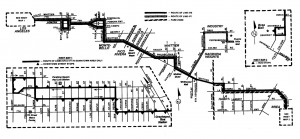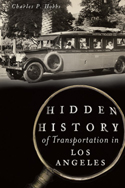Due to the lack of state funding, Foothill Transit may cancel its Route #285, between La Puente and La Habra via Whittier. If #285 is cancelled, and if no other transit agency steps in to replace it, the two-mile stretch of Whitter Bl. between Whitwood Mall and the county line at Beach Bl will be left without transit service.
As I looked at Foothill’s proposal, I thought about the long and interesting history of transit service along the Whittier Bl. corridor.
Streetcar service on what was then called Stephenson Street started in 1903, between Boyle Ave. and Indiana St. This service was extended into downtown Los Angeles in 1910, when the 7th Street bridge over the Los Angeles River opened. Los Angeles Railway through-routed the Whittier Bl streetcar with the West 3rd Street car line, and designated Route “R.” This route lasted through the Los Angeles Transit Lines era (1945-1958)/ The Los Angeles Metropolitan Transit Authority (LAMTA) kept the streetcar going until 1963, when it was converted into a bus route and numbered #28.
Route “R” and #28 provided local service within a few miles of downtown. Buses (also known as “stages”—as in stagecoach) served longer distance trips along Whittier Bl from the mid-1910s.
A variety of bus companies, using modified cars and trucks of all descriptions, fanned out from downtown Los Angeles in those days. Many of these outfits were not particularly well-run businesses, and ended up going bankrupt, or taken over by stronger companies.
P&E Stage Line (the name meant “Package and Express”) was an early bus company that ran along Whittier Boulevard from Los Angeles to Fullerton. After a bad year in 1916, P&E sold its buses back to the dealer and went out of business.
The dealer, Mr. O.R. Fuller, decided to try his hand at the bus business, and reactivated the Whittier Bl. route in early 1917. Fuller was apparently successful at this new venture; by 1924, his bus system, named “Motor Transit” was the largest bus system in California. Motor Transit operated all over Southern California: east to Riverside, San Bernardino and the mountains; south through Orange County to San Diego; and north via the Ridge Route to Bakersfield.
Motor Transit’s Whittier line left downtown Los Angeles from a depot at 5th and Los Angeles Streets, then headed east along Whittier Bl. Since the streetcar also ran along Whittier, Motor Transit was not allowed to provide local service along Whittier until the end of the streetcar line. The first unrestricted stop was at Indiana St. (This restriction remained in place, under Pacific Electric, Metropolitan Coach, LAMTA and RTD operation, until early 1976!)
Going eastward, Motor Transit served the communities along Whittier Bl, such as Montebello, Pico (now Pico Rivera), and “Guadalupe Hidalgo” (aka Jimtown). The route left Whittier Bl to serve central Whittier, then returned to the boulevard, serving East Whittier, crossing into Orange County, through Des Moines (now La Habra), Stewart (now part of Brea), Brea and Fullerton before the final stop in Anaheim. Passengers could continue southward as far as San Diego on certain trips as well.
These were the days before freeways and suburban sprawl; riders on these buses saw little but fields and orchards between the towns. Motor Transit made good time on the (mostly?) two-lane roads; the trip from Los Angeles to Anaheim took about an hour and a half.
Fuller sold Motor Transit to the Greyhound Bus Corporation in 1929. Greyhound took over Motor Transit’s long distance routes (e.g. San Diego, Bakersfield, Victorville), leaving Motor Transit as a suburban bus system. Pacific Electric later bought Motor Transit and replaced certain underperforming rail lines with bus routes. Pacific Electric also decided to number its bus routes in 1943; all of the bus routes operating between Los Angeles and Santa Ana, were called Route #58. The Whittier Bl. route was designated #58W.
In 1966, the Southern California Rapid Transit District (RTD) renumbered Route #58 to #72. The new number was not only much less confusing, but also more appropriate as Whittier Blvd had been designated California State Highway 72 in 1963.
Big changes came to Whittier Bl. bus service in 1976. In response to increasing traffic levels on Whittier Bl. in Boyle Heights and East Los Angeles, RTD modified routes #28 and #72. #28 was extended to Garfield Bl. in Montebello. Whittier Bl. east of Garfield was served by a new line #820, which ran express via the Pomona Freeway from Downtown Los Angeles to Garfield, Whittier, and via the old #72 route to La Habra. A branch of the #820 went northeast along Colima Road towards La Puente, ending at the Puente Hills Mall.
Why La Habra and not all the way to Fullerton? In 1972, Orange County began operating its own countywide bus service. As the new Orange County Transit District (OCTD) grew, it assumed the operation of several former RTD bus routes. The Whittier bus route, which had historically ran all the way to Fullerton, was cut back to La Habra. (In 1980, #820 was extended to Brea to serve the new Brea Mall.)
The early 1980s also brought RTD’s “Great Renumbering.” Route #28 became #18; Route #820 was renumbered to #470 on the La Habra/Brea branch, and #471 for the La Puente branch.
This combination of #18 (serving local trips between LA and Garfield Ave) and #470/471 handling the longer-distance trips continued, with only occasional minor changes, until 1998. By that time, RTD had become known as “Metro,” and traffic conditions on the Pomona Freeway had increased so much that transit officials thought that a limited stop bus would be faster than a freeway express. In June 1988, #470 was replaced with #318, a limited-stop bus route running along Whittier Bl all the way to Brea. #471 became a shuttle route between Whittier and La Puente.
In June 2000, Metro began implementing its “Rapid Bus “ program. A Rapid Bus was a limited-stop bus, except with traffic-signal priority (buses nearly always got a green light) as well as greater stop spacing, giving the bus a higher average speed. Rapid #720 ran from Santa Monica to Los Angeles via Wilshire Bl, then continued eastward via Whittler to the Monebello Metrolink station. Since the Rapid Bus provided higher-speed service along Whittier, Metro saw no need for the #318. Instead, local route #18 was extended eastward from Garfield to Whittier, along essentially the old #72 route.
This left the Brea and Puente Hills branches of the old #470/471. Metro extended the #471 along Whitter into Brea. Now a trip from LA to Brea would require at least one transfer if taking the local #18, or two transfers if using the Rapid bus (once at Garfield from #720 to #18, then again at Whitwood Mall to catch the #470)
In the next few years, service along Whittier Bl. became even more complicated. In mid-2002, Metro cut back all #18 service (except late night) to Montebello Metrolink, leaving service east of that point to be operated by Montebello Bus Lines. (Montebello Bus has an extensive history of its own, which I will cover in a later post.) And in 2004, Metro turned over the #471 route to Foothill Transit, which renumbered it #285. The Foothill route goes no farther than Beach Bl, requiring a transfer to OCTA for trips to Brea Mall.
Since 2004, a trip from Downtown Los Angeles to Brea Mall via Whittier has required not only three changes of bus, but the use of four different transit agencies:
Metro #18 or #720 to Garfield
Montebello #10 to Whitwood Mall
Foothill #285 to Beach Boulevard
OCTA #29 to Brea Mall.
Such a trip would take nearly three hours, including all transfer waits. And I won’t even get started on the differing fare/transfer policies among all these different agencies.
Somehow, I don’t think O.R. Fuller would be too happy with this development….
Sources (most available at Metro Dorothy Peyton Gray Transportation Library):
Vandeventer, Ed, Routes of the Los Angeles Railway (http://www.oerm.org/pages/LARy%20History.htm)
Bail, Eli. From Railway to Freeway (Motor Transit history)
Western Transit (newsletter of the Western Transit Society)
Southern California Association of Governments. Transit Development Program.
(contains histories of bus routes up to 1971)
Jones, Lionel. Los Angeles Bus Line History Book (updated route histories as of 2004)
Comments, corrections or suggestions (to cover another bus line history) welcomed!


Thank you for an attractive display of “salient facts”about Transportation Growth Process and Mentality”, it may help in planning for the future, where the “Riders” needs are taken in cosideration.
The 720 is a step in the right direction; now it has to be “electrified” into a frequent service 24/7 from Fullerton to Santa Monica, join the movement for Tolleybuses on established corridors of LA, we already have an established “GRID”, and ridership has no way back to be reduced, count on it PLANNERS. YA